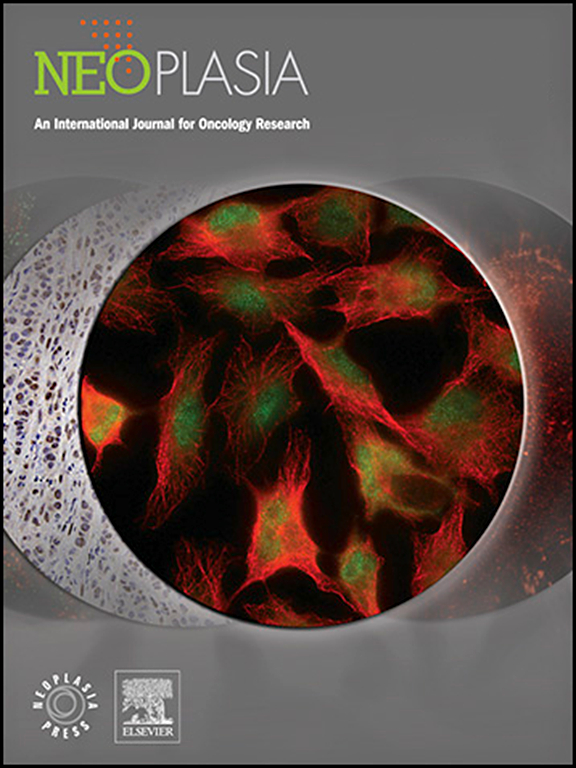T细胞亚群的双相行为反映了早期抗骨髓瘤反应的失败并导致进行性T细胞功能障碍
IF 7.7
2区 医学
Q1 Biochemistry, Genetics and Molecular Biology
引用次数: 0
摘要
多发性骨髓瘤(MM)在20 - 30年的时间里通过两个癌前阶段(MGUS和SMM)进展,最终形成临床活动性疾病。考虑到在这段时间内从患者获得顺序骨髓(BM)样本的局限性,破坏免疫监视并促进MM发展的机制仍然存在。在接下来的220天里,BM骨髓瘤细胞被跟踪。于细胞接种后80、150和220天采集血液和骨髓样本。血液样本用于监测副蛋白水平和全血细胞计数。骨髓抽吸液用于流式细胞术的深度免疫分析和T细胞功能测定。结果血液分析证实该模型反映了人类MM的血清学特征。BM样本分析显示T调节细胞、Th17细胞、CD8+细胞毒性T细胞和NK细胞的双相行为,以及CD4+和CD8+ T记忆细胞亚群分布的倾斜,表明早期抗骨髓瘤反应失败,取而代之的是进行性免疫抑制,CD8+ T细胞肿瘤细胞毒性功能障碍和耗竭。结论我们的新模型是研究早期细胞相互作用启动免疫抑制和MM疾病进展的灵活工具。该模型还可用于测试新的治疗策略的有效性。本文章由计算机程序翻译,如有差异,请以英文原文为准。
Biphasic behavior of T cell subsets reflects failure of early anti-myeloma response and leads to progressive T cell dysfunction
Introduction
Multiple Myeloma (MM) progresses over 2-3 decades through two pre-malignant stages (MGUS and SMM), culminating in clinically active disease. Given the limitations in acquiring sequential bone marrow (BM) samples from patients over this time frame, the mechanisms that compromise immunosurveillance and promote the development of MM remain
Methods
Balb/c mice inoculated with MOPC315.BM myeloma cells were followed over the next 220 days. Blood and bone marrow samples were collected on days 80, 150, and 220 post cell inoculation. Blood samples were used to monitor levels of paraprotein and whole blood cell counts. BM aspirates were used for deep immune profiling by flow cytometry and for T cell function assays.
Results
Blood analyses validated that the model reflects serological features of human MM. Analysis of BM samples revealed a biphasic behavior of T regulatory cells, Th17 cells, CD8+ cytotoxic T cells and NK cells, as well as skewing of CD4+ and CD8+ T memory cell subset distributionss, suggesting failure of an early anti-myeloma response, which is replaced by progressive immunosuppression, and dysfunction and exhaustion of CD8+ T cell tumor cytotoxicity.
Conclusion
Our new model is a flexible tool to investigate the early cellular interactions that initiate immunosuppression and MM disease progression. The model can also be used to test the efficacy of new therapeutic strategies.
求助全文
通过发布文献求助,成功后即可免费获取论文全文。
去求助
来源期刊

Neoplasia
医学-肿瘤学
CiteScore
9.20
自引率
2.10%
发文量
82
审稿时长
26 days
期刊介绍:
Neoplasia publishes the results of novel investigations in all areas of oncology research. The title Neoplasia was chosen to convey the journal’s breadth, which encompasses the traditional disciplines of cancer research as well as emerging fields and interdisciplinary investigations. Neoplasia is interested in studies describing new molecular and genetic findings relating to the neoplastic phenotype and in laboratory and clinical studies demonstrating creative applications of advances in the basic sciences to risk assessment, prognostic indications, detection, diagnosis, and treatment. In addition to regular Research Reports, Neoplasia also publishes Reviews and Meeting Reports. Neoplasia is committed to ensuring a thorough, fair, and rapid review and publication schedule to further its mission of serving both the scientific and clinical communities by disseminating important data and ideas in cancer research.
 求助内容:
求助内容: 应助结果提醒方式:
应助结果提醒方式:


